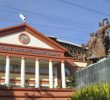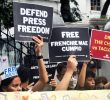The Media Safety Office of the National Union of Journalists of the Philippines (NUJP) and the International Federation of Journalists has released a set of guidelines to help both local and national reporters, photojournalists and mediamen in covering this Monday’s midterm elections.
By DAVAO TODAY
DAVAO CITY, Philippines – The Media Safety Office of the National Union of Journalists of the Philippines (NUJP) and the International Federation of Journalists has released a set of guidelines to help both local and national reporters, photojournalists and mediamen in covering this Monday’s midterm elections.
Below is the list of survival guide:
A. KNOW YOUR RIGHTS
It is during the election season that the public’s right to know is of paramount concern. Journalists should know when and how to assert the rights to information and free press. Knowing this and the different regulations will be useful when going through checkpoints, taking pictures, entering polling areas, taking exit polls and other activities journalists usually conduct in the process of election coverage. In particular, understand election laws, such as the Fair Elections Act, and the provisions related to media.
B. KNOW YOUR RESPONSIBILITY
Fair and balanced media coverage not only promotes truthful and clean elections but also helps minimize risks for reporters as perception of being biased is avoided. Remember to always get the other side and report events exactly as they happened. Clarify newsroom policy on coverage spending. Talk to your editors and colleagues on how to reject bribes without earning a bullet or threat. Remember that ethical journalism is the first line of defense.
C. BE INFORMED
Be as prepared as possible before leaving for your assignment. Know the political, ethnic, religious or any other conflict that may exist in the area where you have been deployed for coverage. Know the dominant political forces and their history — which ones are known for maintaining private armies, being violent if asked a negative question by a reporter, etcetera.
D. HAVE YOUR CONTACTS READY
By this time, you should have already gathered the contact information of the media officers of the candidates, political parties, poll monitoring groups, concerned government agencies and other stakeholders’ groups. Again, having as many contacts as possible will help your coverage but at the same time serve as safety net if trouble erupts.
E. WHAT YOU SHOULD HAVE WITH YOU
Number one of course is your press card. Decide whether it is safer to keep it in your pocket or have it in the open. Bring first aid. Bring food if there is possibility of the coverage extending to several days. Flashlights are important since power outages on election day are normal highlights. Extra clothes, spare batteries, pre-paid mobile phone cards and portable radio for monitoring are all important. Small and large plastic bags may also come in handy during emergencies.
F. KNOW YOUR DESTINATION
Many journalists are usually assigned to far-flung areas during elections. Try to research the area if you have not been there before. Know the safe routes and safe havens (i.e. church, hospitals) in case you need to leave or find a sanctuary. Learn and observe local community practices. This could include who you speak to first when you go into a community, how you address leaders, even what to wear.
G. IN THE FIELD
Never travel alone if going to a risky area. If there is no one from your news organization available, find a colleague to take along. Always tell your editors, colleagues and family where you are going and what time you expect to be back. Listen to the locals. They know best. Watch out for big crowds. They are a good signal for what is happening. If it is too quiet or there are too few or no people on the streets, this could also indicate danger. If there are other journalists about, stick close to them. If you are caught in the middle of a disturbance, move away — but don’t run , or you could be seen as a target. Always have a contingency plan.
H. IF FIGHTING ERUPTS
1. Do not be overconfident. Know your own limitations.
2. Closer is not always better. Think about a higher, more distant, position but safer.
3. Never carry a firearm or weapon — you lose your civilian status.
4. Don’t pick up battle souvenirs — they may explode.
5. Be aware of the potential for error if observing artillery, grenade, even Molotov cocktails. You are at risk of being hit by so-called “friendly fire.”
6. What goes up must come down. Beware of celebratory fire.
7. Pay attention to what others are doing. If other journalists start leaving, they might know something you do not. Pay attention to civilians. If busy streets suddenly empty, consider a rapid withdrawal.
I. DRESS APPROPRIATELY
Always dress in comfortable clothing that does not limit your movement. Definitely no heels or narrow skirts. Avoid expensive jewelries because they make you a walking target for criminals. Be aware of the colors of the political parties active in your area of coverage and avoid wearing them. Avoid t-shirts with political slogans. Wearing clothes that proclaim your identity as a journalist has to be weighed carefully.
J. BE ALERT
…particularly those working on sensitive election stories. Keep a close watch for unusual activities and unfamiliar faces. The philosophy is that, once is happenstance, twice is coincidence, and three times is enemy action. If you feel something is wrong, bring it to the attention of the authorities and your station or newspaper. It is better to suffer a little embarrassment in the event you are wrong, than suffer the consequences if you are right!
The NUJP-IFJ Media Safety Office has encouraged journalists to share these guidelines with colleagues in the media. In case of threats or attacks or other similar incidents, they can be reached through e-mail at nujphil@gmail.com, Twitter (@nujp) or at these numbers: 0917 548 6818/0916 222 1055 for Luzon and Visayas; 0999 536 9592 for Mindanao. (davaotoday.com)











